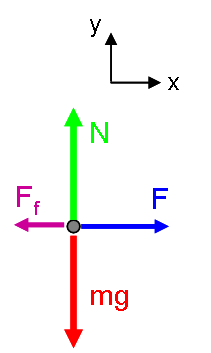| Wiki Markup |
|---|
h3. Part A
A person pushes a box of mass 15 kg along a floor by applying a perfectly horizontal force _F _. The box accelerates horizontally at a rate of 2.0 m/s {color:black}^2^{color}. {excerpt}Assuming the coefficient of kinetic friction between the box and the ground is 2. | Excerpt |
|---|
Assuming the coefficient of kinetic friction between the box and the ground is 0.45, |
__?{excerpt}
h4. Solution
{Solution:=} * System: Interactions: | Cloak |
|---|
| External influences from the person (applied force) the earth (gravity) and the floor (normal force and friction). |
Model: Approach: Diagrammatic Representation The free body diagram for this situation is:  Image Added Image Added
Mathematical Representation With this free body diagram, Newton's 2nd Law can be written: | Latex |
|---|
* {cloak:id=sysa}Box as [point particle].{cloak}
{toggle-cloak:id=inta} *Interactions:* {cloak:id=inta} External influences from the person (applied force) the earth (gravity) and the floor (normal force and friction).{cloak}
{toggle-cloak:id=moda} *Model:* {cloak:id=moda}[Point Particle Dynamics].{cloak}
{toggle-cloak:id=appa} *Approach:*
{cloak:id=appa}
{toggle-cloak:id=diaga} {color:red} *Diagrammatic Representation* {color}
{cloak:id=diaga}
The free body diagram for this situation is:
!pushingboxfrfbd1.png!
{cloak:diaga}
{toggle-cloak:id=matha} {color:red} *Mathematical Representation* {color}
{cloak:id=matha}
With this free body diagram, [Newton's 2nd Law|Newton's Second Law] can be written:
{latex}\begin{large}\[ \sum F_{x} = F - F_{f} = ma_{x} \]
\[ \sum F_{y} = N - mg = ma_{y} = 0 \]\end{large}{latex}
|
where we have assumed that the _y _ acceleration is zero because the box is sliding along a horizontal floor, not moving upward or downward. This realization is important, because we know _ Ff = μN. Thus, because the y acceleration is zero, we can solve Newton's 2nd Law in the y direction to yield: | Latex |
|---|
_~f~ = μ_N_. Thus, because the _y_ acceleration is zero, we can solve Newton's 2nd Law in the _y_ direction to yield:
{latex}\begin{large}\[ N = mg\]\end{large}{latex}
|
so that:
{| Latex |
|---|
}\begin{large}\[ F = ma_{x}+F_{f} = ma_{x} + \mu_{k}N = ma_{x} + \mu_{k}mg = \mbox{96 N} \] \end{large}{latex}
{cloak:matha}
{cloak:appa}
| |